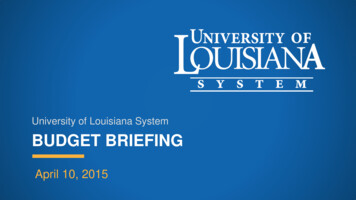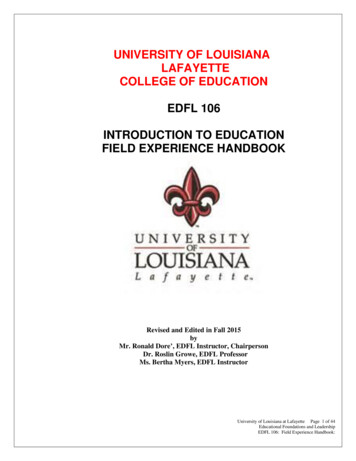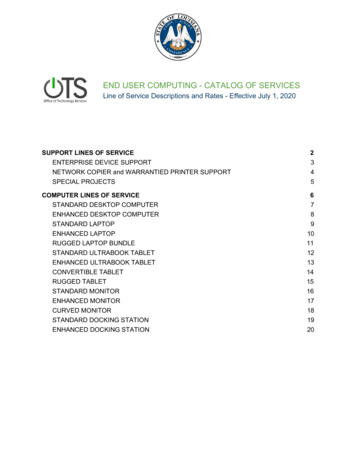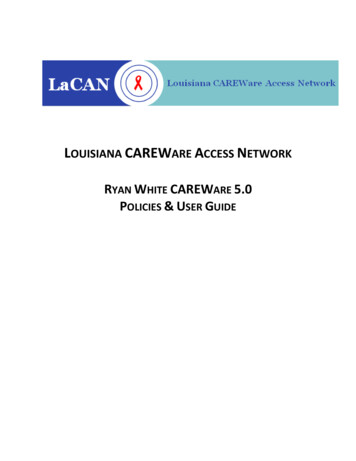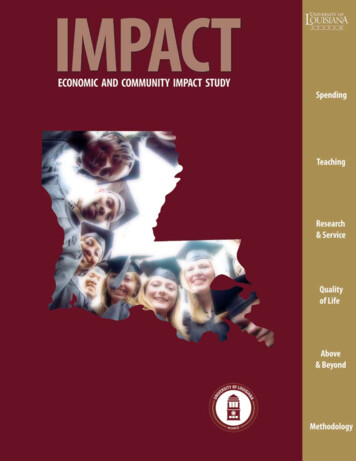
Transcription
University of Louisiana SystemBoard of SupervisorsMrs. Elsie P. Burkhalter, ChairMr. E. Gerald HebertMr. Winfred F. Sibille, Vice ChairMr. Jeffrey JenkinsMr. D. Wayne Parker, ParliamentarianMs. Renee A. LapeyrolerieMr. Paul G. AucoinMr. Jimmy D. Long, Sr.Mr. Andre G. CoudrainMr. Russell L. MoselyMr. Edward J. Crawford, IIIMr. Carl G. ShetlerDr. Mildred G. GallotDr. Eunice W. SmithMr. Gregory S. Hamer, Sr.Ms. Morgan Verrette, StudentAcknowledgmentsMany hours were contributed towards the datacollection, analysis, review, and production ofmaterials associated with the Economic andCommunity Impact Study. Special thanks aredue ULM’s economic impact study committee,led by Dr. Richard Hood, executive assistant tothe president; Dr. Robert Eisenstadt and Dr. PaulNelson, professors of economics; Robin Loganand Justin Roy of university planning and analysis;Priscilla Turner, special events assistant; and LauraHarris, director of media relations. Special thanksalso to Keli Jacobi, staff writer, Rene Hearns,director of Sponsored Programs and Research,and Gail Parker, budget officer.
A Message from University ofLouisiana at Monroe PresidentJames CoferEducation is economic development. Encouraging youngscholars to flourish, thereby benefiting the global society,embodies the true spirit of this incredible institution.This economic impact report highlights just a few ofULM’s significant contributions to greater Louisiana, thesurrounding region, and the country. You will discoverthe breadth of our reach in the professional servicesprovided by our faculty, staff and students, the innovativeresearch conducted by our faculty, and the volunteerhours regularly contributed by our university family.college credits but have not completed their degrees. ULM’sGateway to Online Degrees strives to educate today’s“anytime, anywhere” student. Our new online health studiesdegree prepares professionals for mid-level managementpositions in a variety of health care organizations andincreases the capabilities of our state’s workforce. That kindof educational outreach is the cornerstone of economicdevelopment. By making higher education available toall Louisianians, we are ensuring a brighter economicfuture and quality of life for our entire state and region.Much of what we contribute to the state and region is uniqueto our institution. For example, our nationally-renownedCollege of Education and Human Development’s LouisianaLeader Fellows Program, hailed by Governor Bobby Jindalas the premier program in the state, empowers talentedteachers to become principals in their schools. In addition,ULM’s College of Pharmacy, Louisiana’s only state-supportedprogram, continues to produce the best professionalsin the field, and our nursing students continue to scoresignificantly higher than the national average on exit exams.Another part of our story, our commitment to northeasternLouisiana, is exemplified in the revitalization of ouruniversity—both within and beyond our classrooms.By 2010, we will have spent more than 80 million inclassroom upgrades and campus improvement projectsin an effort which was launched in 2002. That is adirect and concerted investment in our students andin northeastern Louisiana. In addition, our professorscontinue to expand their methodologies, and many nowincorporate emerging technologies into their curriculums.These programs and many others exemplify an impressiveand growing tradition of excellence. We are also constantlyevolving and expanding our idea of the university. Forexample, we are strengthening our state by providing coursesto the 600,000 Louisiana adult learners who have earnedFinally, ULM contributes to something quite incredible: thevitality of our state and region. Investing in higher educationis crucial to our economic future because it means we envisiona potential for growth and new possibilities for LouisianaContents5University of LouisianaSystem17Impact of Research &Service9Impact of Spending21Impact on Quality of Life13Impact of Teaching25Above & Beyond 29Methodology
EIGHT UNIVERSITIES STRONG: With over 80,000 students, the University of Louisiana System is the largesthigher education system in the state and produces about half of all undergraduate degrees.
University of Louisiana SystemInstitutions of higher learning have a direct impact onthe economic success of a state and region, and thereis a direct correlation between higher education andthe positive outcomes on quality of life measures.System enrich each of the state’s 64 parishes.As evidenced in the comprehensive study of the economicand community impacts of the eight universities in theUniversity of Louisiana System, investments in highereducation have a ripple effect on the economic vitalityof the entire state and the quality of life of its citizens.In essence, higher education pays.College graduates earn more and spend more than thosewithout a college degree. The taxes paid by collegegraduates are greater and are used for the public good,including repaying the cost of a college educationseveral times over.Our universities provide jobs, train future workforces,incubate businesses, create and bolster newindustries, enrich the lives of residents throughthe arts and humanities, and sustain the financialstability of communities where they are located.The state’s investment in higher education is aninvestment in the future of Louisiana as college graduatesare productive members of society, paying taxes,volunteering, voting and raising families with similargoals of attaining a college degree.The combined impacts of Grambling State University,Louisiana Tech University, McNeese State University,Nicholls State University, Northwestern State University,Southeastern Louisiana University, the Universityof Louisiana at Lafayette and the University ofLouisiana at Monroe are in the billions of dollars.With over 80,000 students, the University ofLouisiana System is the state’s largest highereducation system. Consisting of eight four-yearuniversities strategically located across the state,the economic and quality of life impacts of the ULSpendingThe UL System’s statewideannual economic impact is 3.4billion and supports 34,800 nonuniversity jobs.This includes: 101 million from affiliatedorganizations, 148 million in healthinsurance payments, 131 million impact of retireespending, 334 million in universityoperations, 222 million in constructionand capital outlay, 487 million from visitors, 661 million in faculty andstaff expenditures, and 1.3 billion impact fromstudent spending.Quality of LifeThe UL System enhances lifeexperiences of its students,employeesandcommunitymembers by creating uniquelearning and cultural opportunities.That’s the power of EIGHTUNIVERSITIES STRONG.TeachingUL System graduates haveadded 6.5 billion to Louisiana’seconomy over the last 10 years.Bachelor’s degree holders havegenerated 5.6 billion, master’sdegree holders 728 million, andassociate’s degree holders 143million.Research & ServiceULSystemcampusesarebolstering opportunities for newindustry growth and enhancingestablished industries in Louisianathrough innovative research anddevelopment and by providingstrategic planning and professionalservices.UL System schools produced455,669 degrees over the last50 years with 122,974 graduatesbetween 1998 and 2007.This study captured 188 researchand service programs in the ULSystem.In the past 10 years the UL Systemgenerated the majority of graduatesin the fields of criminal justice,family and consumer sciences andhuman sciences, health and fitnessstudies, public administration andsocial work, health professions andclinical sciences, education, visualand performing arts, computer andinformation sciences, and business,management and marketing.On average, there are 100 eventstaking place every day at UL Systemcampuses.Last year, campusevents attracted 3.7 million people,45 percent of those being offcampus visitors. They include: 28 in economic development, 23 in engineering andtechnology, 27 in cultural development, 24 in environmental andnatural sciences, and 86 in education, health andhuman services.Additionally, UL System faculty andstaff volunteered 567,000 hourslast year, and students logged 1.9million hours in their communities.
University of Louisiana SystemThe University of Louisiana System is comprised of: Grambling State University, Louisiana Tech University, McNeese StateUniversity, Nicholls State University, Northwestern State University, Southeastern Louisiana University, University of Louisianaat Lafayette, and University of Louisiana at Monroe. The value added to Louisiana’s economy by increased taxable earningsof UL System graduates over the last 10 years is 6.5 billion.“Eight Universities Strong” is morethan just a tagline. It’s a reflectionof the collaborative partnershipsthat exist between the eightinstitutions in the Universityof Louisiana System.allows students to enroll in courses at any of theparticipating universities and receive credit towarda master’s degree. Accredited by the NationalLeague for Nursing Accrediting Commission,the advanced nursing specialty tracks offeredare nursing administration, nursing education,clinical nurse specialist, and nurse practitioner.From joint degree programs topooling resources for costsavings measures to studentinitiatives, the UL System provesuniversities enhance their individual impacts whenworking together.Grambling State University in Grambling, LouisianaTech University in Ruston, and the University ofLouisiana at Monroe established the LouisianaEducation Consortium (LEC) in 1995 to offer a jointdoctoral program in education. With specializationin either curriculum and instruction or educational“Our universities have a history of workingleadership, the Doctor of Education (Ed.D.) degreecollaboratively through joint programs and sharing ofprogram has generated 85 graduates. Over tworesources. We want to build upon that foundation, asthirds of those graduates currently work in K-12 orwe are good stewards of taxpayer dollars invested in our higher education in Louisiana, Texas, and Arkansas.enterprises,” said UL System President Randy Moffett.Southeastern and UL Lafayette also offer a jointWorking Together in Teachingdoctoral program through the Consortium for Ed.D.Three strong joint degree programs already existin Educational Leadership. Established in 2006, thebetween UL System universities.program will award its first degrees in May 2009. Inorder for more efficient course delivery, each universityMcNeese State University in Lake Charles,has primary responsibility for certain program courses.Southeastern Louisiana University in Hammond, andThus, those enrolled at Southeastern take seventhe University of Louisiana at Lafayette comprisecourses offered by UL Lafayette, and UL Lafayettethe Intercollegiate Consortium for a Master ofstudents take seven courses offered by Southeastern.Science in Nursing. Created in 1986, this consortium
University of Louisiana SystemUL System President Randy Moffett has askedthe eight university presidents to explore furtheropportunities for establishing new joint courseofferings and degree programs.Council (SAC). SAC consists of the StudentGovernment Association Presidents from each ofthe eight universities and meets regularly to shareinformation and identify ways to work collaboratively.“We want to see more cooperative endeavors likethese across our system. It’s good for the studentsin terms of expediting degree attainment; it’s goodfor faculty in terms of peer development; and it’sgood for our state in terms of a higher educatedcitizenry and fiscal responsibility,” said Moffett.Past UL System student-led initiatives include the“RU Ready?” campaign, where university studentsvisited middle schools across the state to talk aboutthe importance of college preparation, and ExtremeSpring Break, where college students traded theirspring breaks to rebuild the Gulf Coast afterHurricanes Katrina and Rita.Working Together for Cost SavingsLooking beyond academic collaborations, the Boardof Supervisors for the University of LouisianaSystem recently established a Cost Containment andEfficiencies Committee. The committee is researchinghow to build upon existing collaborations betweencampuses and pool resources to streamline costs.Currently, UL System students are the cornerstone ofthe system’s service-learning and mentoring initiatives.Through a three-year, 1.2 million grant from theNational Corporation for Community Service’s Learnand Service America Division, the UL Systemfunded 70 service-learning projects and nine relatedmentoring programs. These projects have alreadyengaged 675 faculty and staff, 8,462 college studentsand 243 community partners.In the beginning stages of their work, the committeehas already identified four ways to work collaboratively: Energy – The committee is looking at thefeasibility of purchasing electricity in bulkquantities for the UL System. Credit Card Processing Fee – The committee iscollecting information from the universities toexplore ways to lower credit card processing fees. Telecommunications – The committee is workingwith the Office of Telecommunications (OTM) todetermine if there are ways to cut costs for local,long-distance, e-mail, and internet connections. Healthcare – The committee is exploring thefeasibility of setting up a healthcare insurancenetwork for UL System faculty, staff, andstudents and other options.ConclusionAs the largest higher education system in the state,the reach of the eight universities’ 9,500 employees and80,000 students is broad. Leveraging the powerof eight four-year universities has yielded collaborativepartnerships that touch academics, students andcampus operations.As the Economic and Community Impact Studyreveals, each university has a significant impact on thestate’s economic vitality and the quality of life ofits citizens. Collectively, that impact grows toa 3.4 billion impact each year that touches all 64parishes in Louisiana.“Eight Universities Strong” is more than a tagline. Itdefines and guides the work of the largest system inthe state. The University of Louisiana System isEIGHT UNIVERSITIES STRONG!Working Together for Student InitiativesThe UL System is a student-centered system, asevidenced by the Board-recognized Student AdvisoryAbout the StudyInitiated in August 2008, the University of LouisianaSystem Economic and Community Impact Studywas conducted by Applied Technology ResearchCorporation of Baton Rouge. The study relied ondata provided by the eight universities, the Universityof Louisiana System, the Louisiana State EmployeesRetirement System, Teachers Retirement System ofLouisiana, and the Office of Group Benefits. Themethodology used is consistent with that of otheruniversity impact studies conducted around thenation.
SpendingModern apartment-style housing overlooks Bayou DeSiard on the University of Louisiana at Monroe campus.ULM construction spending had an economic impact of 216 million.
IMPACTSpending 8 Return for Every 1 Louisiana Invests in UL SystemThe University of Louisiana at Monroe is an essentialeconomic driver to the state and the communitiesit serves. With sustained expenditures by theinstitution, its employees, and its students, theuniversity provides significant economic benefits.Job CreationAn additional benefit to ULM’s spending is thecreation of 3,669 non-university jobs throughoutLouisiana. These are full-time equivalent positionsthat support expenditures such as construction,healthcare, and food services.The impact of each dollar invested in the UL Systemis multiplied by eight as it cycles through ourstate economy.StudentsULM’s enrollment plays an important role insupporting the community. Student spending inareas such as housing, food, entertainment,telecommunications, and transportation generates anannual 129 million impact on Louisiana’s economy.ULM has a total spending impact of 350 million.That includes a 39 million impact from universityoperating expenditures, 27 million from capitaloutlay and construction projects, 19 million fromhealth insurance payments, 18 million from retireespending, 29 million from visitor expenditures, 77 million from spending by faculty and staff,and 129 million from student expenditures.Student spending at ULM also supportsnearly 1,300 non-university jobs in Louisiana’srestaurant, entertainment and retail industries. 350 MillionAnnual ImpactIMPACTby Source Spending
Spending3,669 non-universityjobs created as a result ofULM spendingSpendinguniversity jobs tied to university constructionprojects each year.Faculty/StaffThere are over 1,200 faculty and staff employed by theUniversity of Louisiana at Monroe. Their expenditureson items such as housing, food, entertainment,telecommunications, and transportation generate anannual 77 million impact on Louisiana. Thoseexpenditures also support over 700 jobs.VisitorsEach year, ULM hosts numerous visitors forcultural, sporting, and educational events. Visitorexpenditures on items such as transportation, food,and lodging impact the state economy by 29 million.University OperationsIn 2007-08, ULM’s operating expenditures on itemssuch as supplies, equipment, and services garneredan impact of 39 million on the state, with almost 600jobs created as a result of university operationsexpenditures.Visitor spending also accounts for approximately300 jobs.Health InsuranceAbout 92.2 percent of ULM health insurancepayments are made to health care providers inLouisiana. Those payments generate an economicimpact of 19 million and create nearly 200 jobs.ConstructionBetween 2001 and 2008, seven construction projectsoccurred on ULM’s campus. Those projects yieldeda 216 million impact on the state and createdmore than 2,000 jobs.RetireesApproximately 84 percent of ULM’s retired facultyand staff reside in Louisiana, adding 18 millionto the economy after their employment at theuniversity. Their spending supports almost 200 jobs.An eight-year average of construction at theUniversity of Louisiana at Monroe revealed anaverage annual impact of 27 million, with 250 non10
SpendingGuy BarrRetired Regional Vice Presidentfor State Farm InsuranceMonroe, La.Spending“ULM is the crown jewel in our community.It is the leading economic engine.Affiliated OrgnanizationsAffiliated organizations are third-party entitiesthat perform services on behalf of the university.This includes food services, bookstores, housingmanagement, and foundations. Spending by theseorganizations generates an annual impact of 12 million.“Our university provides so much diversityboth academically and in the sports arena.We enjoy speeches and plays that otherwisewouldn’t be here, and those are things thatmake a community come alive.”ConclusionStrong, significant, and symbiotic relationshipsexist between local businesses and the universitycommunities they serve. The presence of UL Systemuniversities are economic engines in their regions.“We live in one of the most impoverishedareas in the United States. Every oneof our problems can be solved througheducation.“These study results demonstrate the extentto which Louisiana’s economy and theDelta region, in particular, are tied to theUniversity of Louisiana at Monroe.“ULM is so vital.”11
TeachingDr. Thillainataraja Sivakumaran, Assistant Dean of Assessment & Accreditation in the ULM College of Educationand Human Development, instructs students in the new state-of-the-art Digital Media Studio, funded in part bya ULS Serves grant. Students and faculty learn to incorporate technology in the classroom, using moderntechniques such as podcasting.12
IMPACTTeachingULM Graduates AreLouisiana’s WorkforceThe University of Louisiana at Monroeproduces quality graduates that create, enhanceand support Louisiana’s workforce. 784 MillionULM has awarded 63,288 degrees over the last 50years. More recently, over the last 10 year
Grambling State University in Grambling, Louisiana Tech University in Ruston, and the University of Louisiana at Monroe established the Louisiana Education Consortium (LEC) in 1995 to offer a joint doctoral program in education. With specializ
